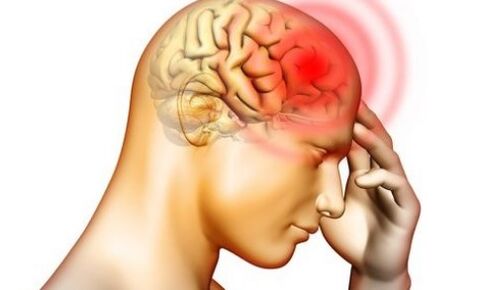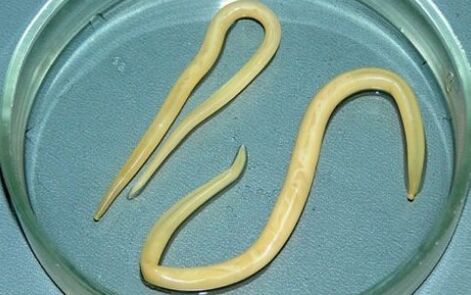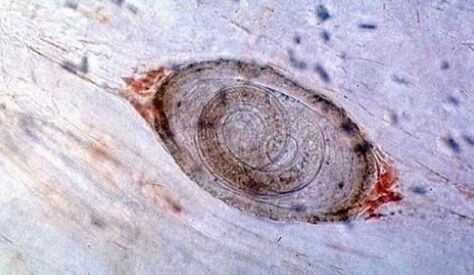Human parasites are called all organisms that live at their expense. These are bacteria, fungi, worms. Human parasites are divided internally and external. The most unpleasant and causing the greatest number of destruction of the body are the Helmints, a variety of parasitic worms.

Parasites and human body
Parasitated creatures in the human body can be external or internal. The external includes:
- Mosquitoes
- Sanguijuelas.
- Lice.
- Microorganisms that cause scabies.
But there are many more creatures that prefer to establish themselves inside the body. These include:
- Bacteria
- Appropriate.
- Helmintos.
- Fungus.
The external and internal organization of the parasite belongs to the simplest. Due to the fact that they do not need to evolve for the sake of survival, their organization is greatly simplified.
There are many creatures that prefer to establish themselves inside the body. For example, it can be bacteria.
They cannot survive without the host body, unable to obtain their own food. But everyone reproduces, almost without exception, very quickly, especially in the right conditions for that. Where they are not immediately driven.
They differ territorially. Some can be found everywhere, no climate for them is an obstacle. Others live exclusively in tropical countries, but in the human body they can easily take any other. In the body, they are also established in different places.

Parasite development cycles, mainly helminths, are also diverse. Some at first develop on the ground (Biohelmintos), and then move to a living creature. Others must first develop in the body of any other living creature, but not in a person. Thirdly, in an adult state, you can transfer to another or return.
It is wrong to assume that the infection can occur exclusively through dirty hands. The eggs of some helminths are viable outside the nutrient for six months and adhere to animal wool perfectly. The eggs survive in a dangerous environment for them: it is worth cooking meat or fish incorrectly, when you can pay an entire breeding of worms inside you.
It is worth cooking meat incorrectly, how you can pay an entire breeding of worms inside you.
Endoparasites of a person
The parasites are divided into endoparasites and ectoparasites. Endoparasites, those that settle inside, ecto, outside. Endoparasites can be established in almost all internal organs and body tissues. They are divided depending on the location. Endoparasites are:
- Connect to the external environment of endoparasites of the internal organs.
They were established precisely in those organs that are connected to the external environment, not vice versa: the parasite body is not chosen to "breathe". Such organs include intestines, light, human urine system. These are amoebas, worms and ardent parasites.
- Parasites
Set in human blood. They can live in plasma, white blood cells, red blood cells. These are tripanosomas, microfilariae or we have paid.
- Cloth endoparas.
Those endoparasites that the body's tissues choose with their place of residence. Muscle tissue, brain, cartilage, connective. Even in nerve fibers, tissue endoparasites can settle. These are fins of the strip worm, Tripansomas, Mixosporidia, Trichina and others.

Endoparasites can choose the brain with their place of residence.
The determination of the variety of parasites in the place of its location is very conditional. Many species can migrate to several internal organs, travel regularly to the owner's body. The propagation process can occur in one place, and organisms will be directly and will feed on another. The place where the parasite is justified and the place of its conditional location will be considered.
Despite the simplification of many parasite systems, its life cycle is quite complicated.
Some varieties throughout their lives for survival have to change several owners who can relate to different biological species. Others can survive only a biological species inside, but may require intermediate guests. In one person, they multiply, and in another they develop and grow. With such a complex life cycle, their sexual functions increase significantly. It is necessary to multiply for survival in body parasites quickly and a lot.
Helmintos
There are three main varieties of helminths, also called worms. This:
- Nematodos, are round worms.
- Cestodes, endoparasites of the shape of the tape.
- Trematodes, also known as dishes.
Then, they can be divided by the life cycle and the amount of locations that pass through this path. There are also three types:
Geo-Shelmints.
"Ge" is the earth. These worms begin their existence in the earthly soil, only after the maturation stage they can infect a person. They do not need intermediate guests, eggs fall on the ground along with human feces. For the Larval stage, they develop exclusively in the warm station.
Such worms include ascárides, intestinal ugritsy, a non -runs and the blazo -cabezas.
The larvae of these parasites can enter the human body through unusual vegetables or direct contact with the ground.
Biohelmintos.
These are parasitic worms, whose stages of life pass through several owners. Intermediate hosts can be two or more depending on the variety of worms. Some parasites change exclusively to a person. Others, before finally entering the human body, are used by organisms from other biological creatures for development.

It can infect through pets or in contact with other people, also by consuming meat in a broken half. Biohelmintos include bull tapeworms, echinococcus, wide tape, trichina and others.
Helmintos contagion.
These worms do not need land or intermediate owners. All stages of your life cycle pass in an organism, located very comfortably. The larvae stand out directly from the human body, when contacting domestic surfaces and other people, extending freely.
Helminants can live in different organs and systems of the human body, periodically migrating from one part of the body to another.
The list of diseases caused by Helmintos is very extensive. Determine which parasites live in the body and what treatment can be started only after all the necessary analyzes are approved to establish the type.
Round worms
The most widespread in the human environment were round worms, also known as nematodes. In total, there are more than 24 thousand types of nematodes in the world.
They are round due to their shape, which is detected if it makes a cross section. The most common human nematodes:
- ASKARIDS.
- Speakers.
- Trichina
- BLACOVYV.
The helmi -invasion, known as ascariasis, begins with direct contact with the infected larvae of the soil or when used without washing fruits and vegetables. The parasites begin to develop in the intestines, then enter the circulatory system of a person, from where they go to different internal organs, addressing the oral cavity. A person, without realizing this, repeatedly swallows an adult parasite. They feed on the remains of undigested foods. The waste of the Ascaris is extremely toxic. There is no ascariasis vaccine, infection can be prevented exclusively by observing personal hygiene rules.
Pinbiasis worms infection is called enterobiasis. These are small worms (5-10 mm) united to the walls of the intestine. They feed on blood and intestine content. They put their eggs under the skin, leaving the anal opening outside while the owner is sleeping. Due to itching, a person who combines the anal region, the larvae falls under the skin and hands, can be easily transferred to other people in the house or in public places. Enterobiosis has no painful symptoms, the detection of worms infection pins in the initial stage is extremely problematic.
Trichinella, are Trichina, these are round worms that choose an animal or person with their teacher.

Trichinella is a parasite worm that affects the human body, causing a dangerous vermis disease of trricinelosis.
They begin to develop in the area of the crossed stripes of the body, then redirect the small intestine. In advanced cases of kilogram of muscle tissue, about 15 thousand trichinella eggs can be located. These parasites can cause deadly disease, which is named after its source: trricinelosis.
Round blazovios worms are called that due to their appearance. The front of your body is a filament, it contains a esophagus.
The back is wider, the remaining internal organs of the parasite are found in it. The length of the blazoles can reach 50 mm. It feeds on blood, as well as tissue liquid. It causes tricocephaly disease.
Tape worms
In the world there are about 3, 500 species of famous strips, the type of which is also called Cestodes. There are no digestive systems in these flat worms, and the diseases they cause are called cestidosis.
The most common cestodose:
Cystistrochosis.
The disease of the larvae of the pork is excited, entering into the contaminated food, of dirty hands.
The disease affects the skin, bones, internal organs, brain and spinal brain. Most of the time, parasites are sent to the brain (in 60% of cases of infection). It is diagnosed based on the appearance of rounded formations in the skin. The disease is, in case of infection of the central nervous system, the forecasts can be unfavorable.
Echinococosis.
Located in the liver, lungs, many other internal organs. Echinococcus larvae excite the disease. They can develop within a person for several years.
The infection occurs in contact with animals, collecting berries and fruits, contaminated water consumption. The disease is not too remarkable, it can be developed for years and is revealed only by accident.
Alveococosis.
Alveocosis is caused by Alveococcus worms. The disease is similar to equinococosis, but proceeds more serious. It affects the lungs and kidneys. Without the treatment of the disease, there is a great probability of fatal result in relation to the development of liver failure.
Toniaria.
Tusiarincosis is caused by a bull chain. Parasitiza had it in the Delgado intestine area, it develops for 2. 5-4 months. The forecasts are more often favorable for treatment. Parasites can enter a person with raw meat infected or insufficiently thermally treated meat.
The tape worms are very fertile. They have the lowest rest of sensitivity and there is no digestive system at all. Such parasites cannot develop without the owner.
Sustain workers
Supreme is tremontodes. These are flat worms, in the form of your body that resembles an oblong leaf of a tree.
Some types of trematodes can reach a size and a half size.
And they are found in the human body, more frequently they are through fish or other shellfish. Around 7200 types of trematodes are known, 40 of them are established in people and cause trematodosis, serious diseases caused by infection.
The most common salars:
The liver bicom.
Globally common, it can exist in animals and people. The biological life cycle is complex, the parasite changes to the owners.

Schistosome
Shabing larvae can penetrate the skin or mucous membrane. The life cycle is complex, it feeds on blood. A female can produce about 3, 000 eggs per day, the fertility of these parasitic worms is very high.
Other liver balemines.
Opistorchiasis, Helminos disease, which spread mainly in the liver area. The human body has a toxic effect.
The digestive system of worm worms is well developed and with TI-Sexual and excretor. The rest of the systems develop badly. Tremontes feed on blood, epithelial skin cells, intestine content. They can live almost anywhere: from the liver to the conjunctival eyes of the eyes.
Other types of endoparasites
The remaining internal parasites are a variety of bacteria that cause dangerous diseases, and with them the simplest microorganisms. The fungus that spreads within the human body also refers to the Endoparasitas section.
Many useful and harmful microorganisms live in the human body. Some of them cause quite dangerous diseases that can lead to death. It is not always possible to immediately recognize the presence of parasitic creatures within you, but the early diagnosis of infection gives more possibilities to complete the cure. If the invasion is suspected, it is recommended to quickly undergo a complete exam by a doctor.


























